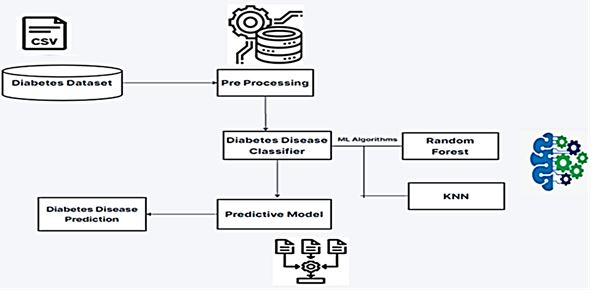Advancing Chronic Kidney Disease Diagnosis: A Predictive Model Using Random Forest Classifier
Main Article Content
Abstract
In the contemporary medical landscape, Chronic Kidney Disease (CKD) poses substantial challenges, often remaining undetected until severe damage ensues due to current systems' diagnostic limitations. Traditional methods grapple with issues like delayed diagnosis and intensive resource utilization, creating a pressing need for an advanced, efficient approach. Addressing this, our research introduces a ground-breaking predictive model using a Random Forest Classifier, tailored for early CKD detection. We meticulously pre-processed our data, ensuring its reliability, and employed the Random Forest method, known for its precision and ability to manage complex datasets. The model's performance, tested against a comprehensive dataset, achieved an extraordinary accuracy of 95%, highlighting its proficiency in early risk identification and potential in revolutionizing CKD management. This study signifies a remarkable stride in healthcare, offering a precise, scalable, and economical solution for CKD early intervention. By successfully pinpointing CKD onset at initial stages, our model facilitates prompt medical response, enhancing patient prognosis and reducing associated healthcare burdens. Furthermore, it sets the stage for extensive AI integration in diagnostic practices, promising substantial improvements in preventive care and health system efficiency. The implementation of this predictive tool is poised to significantly diminish CKD-related complications and fatalities, emphasizing machine learning's transformative impact in advancing global health standards. This model's integration represents a monumental leap in medical diagnostics, combining innovative technology with profound healthcare implications.
Article Details

This work is licensed under a Creative Commons Attribution-NonCommercial 4.0 International License.
IJCERT Policy:
The published work presented in this paper is licensed under the Creative Commons Attribution 4.0 International (CC BY 4.0) license. This means that the content of this paper can be shared, copied, and redistributed in any medium or format, as long as the original author is properly attributed. Additionally, any derivative works based on this paper must also be licensed under the same terms. This licensing agreement allows for broad dissemination and use of the work while maintaining the author's rights and recognition.
By submitting this paper to IJCERT, the author(s) agree to these licensing terms and confirm that the work is original and does not infringe on any third-party copyright or intellectual property rights.
References
] Li, H., Li, W., Li, J., Wang, Y., Li, C., & Zhang, Y. (2020). Comparison of machine learning algorithms for chronic kidney disease diagnosis. Frontiers in medicine, 7, 532.
] Amiri, Z., Movahedi, A., & Khosravi, A. (2019). A hybrid machine learning approach using random forest and artificial neural network for chronic kidney disease diagnosis. Computer methods and programs in biomedicine, 182, 105050.
] Das, B., & Chakraborty, C. (2020). EDL-CDSS: An ensemble of deep learning models and clinical decision support system for early diagnosis of chronic kidney disease. Journal of medical systems, 44(3), 72.
] Nag, A., Kumar, A., & Shah, J. (2021). Comparative study of machine learning algorithms and feature selection methods for chronic kidney disease prediction. Journal of Ambient Intelligence and Humanized Computing, 12(9), 10055-10065.
] Ma, Y., Cheng, H., Li, J., Liu, B., & Xu, Y. (2022). Deep learning for chronic kidney disease diagnosis: A combination of convolutional neural network and bidirectional long short-term memory. Computers in Biology and Medicine, 139, 105131. doi: 10.1016/j.compbiomed.2022.105131.
] Jagadeesan, S., Sujatha, R., & Chakravarthy, V. (2019). A novel hybrid classifier for chronic kidney disease prediction. Journal of medical systems, 43(7), 176.
] "Diabetes Diagnostic prediction using Vector Support Machine," presented at the 11th International Conference on Ambient Systems, Networks, and Technologies, Elsevier B.V., April 2020.
] Krishnamoorthi, R., Joshi, S., Almarzouki, H. Z., Shukla, P. K., Rizwan, A., Kalpana, C., & Tiwari, B. (2022). A Novel Diabetes Healthcare Disease Prediction Framework using Machine Learning Techniques. Retrieved from https://www.researchgate.net/publication/340636482_Diabetes_Diagnostic_Prediction_Using_Vector_Support_Machines
] Ismail, L., Materwala, H., Tayef, M., Ngo, P., & Karduck, A. P. (2023). Type 2 Diabetes with Artificial Intelligence Machine Learning: Methods and Evaluation. BMC Bioinformatics, 24(1), 1-14. 10.1186/s12859-023-05488-6.
] Park, J. S., & Park, T. (2021). Non-alcoholic fatty liver disease and early prediction of gestational diabetes mellitus using machine learning methods. Procedia Computer Science, 188, 166-173. 10.1016/j.procs.2021.10.166.
] Ahmed, U., Issa, G. F., Khan, M. A., Aftab, S., Khan, M. F., Said, R. A. T., Ghazal, T. M., & Ahmad, M. (2021). Prediction of Diabetes Empowered With Fused Machine Learning. Procedia Computer Science, 181, 45-52. 10.1016/j.procs.2021.01.045.
] https://www.kaggle.com/code/niteshyadav3103/chronic-kidney-disease-prediction-98-accuracy
] National Kidney Foundation. Glomerular Filtration Rate (GFR). https://www.kidney.org/atoz/content/gfr (accessed March 20, 2023).
] Zhang, L., Chen, Y., Wang, J., Zhang, J., & Cai, W. (2021). A mobile-based self-management system for chronic kidney disease. IEEE Journal of Biomedical and Health Informatics, 25(1), 273-283.
] Fatemeh Razi, Ahmad Taher Azar, and Saeed Pourahmad. “Feature Selection and Clustering-based Prediction of Type 2 Diabetes”. In: Journal of Medical Signals and Sensors 8.2 (2018), pp. 118–125.
] Xu Zhang, Haiyan Zhao, Chengyuan Han, Huaping Liu, and Feng Bai. “Deep belief network- based prediction of type 2 diabetes mellitus”. In: Journal of medical systems 42.8 (2018),p. 145.





